Our main reason for hanging out at Huntsville State Park the last two
weeks was so Jim could train for the 50-mile
Rocky Raccoon race in which
he was entered.
Unfortunately, his right knee hasn't adequately healed from the
meniscus surgery he had in early December. Running too soon afterwards at ATY in the Phoenix area
on December 29 apparently wasn't the best idea. A few days ago,
after consulting with his orthopedist in Roanoke by phone, he decided to give his knee a
total rest from running for at least a month.
That meant withdrawing from Rocky Raccoon, not an easy decision for
him to make.
Oddly, his knee feels just fine when he's walking or running or
riding the bike. It only hurts when he's sedentary, especially when he's
trying to sleep. It often keeps him awake at night.
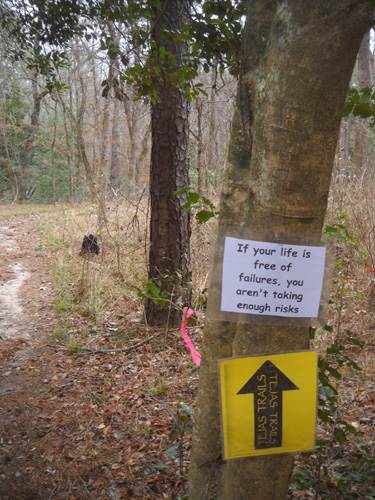
One of several motivational signs on the course
Last year when plantar faciitis disrupted Jim's training and prevented
him from running this
race, we volunteered at the start/finish in the drop bag area and did some other jobs before and
after the event. Neither of us was up to that much physical work this
year so we were just spectators on race day. Jim picked up his packet
but we didn't watch the race starts/finishes or go to the awards ceremony.
It's becoming more difficult for either one of us to maintain a high
level of interest in ultras when we can't run.
We did have some friends running in the race, however. We talked with
several of them at packet pick-up and cheered them on during the race.
Later in this entry I'll show photos of some of the runners at the two
places where we observed the race.
WEATHER CHALLENGES FOR RACE STAFF
TUESDAY-WEDNESDAY, FEB. 1-2
I mentioned in the last entry about the massive winter storm that blanketed
much of the eastern two-thirds (maybe more) of the country in ice and
snow this past week. That caused some major problems for both race management
and many of the 700 runners entered in this race.
Yes, Rocky has grown
that large!
The high winds blew down several trees on the course. Between Tuesday
and Friday I hiked or cycled all but three miles of the 20-mile loop
used in the 100-mile race and all of the 50-mile course (16+ mile loops).
Rangers and/or volunteers removed all of the blow downs by Friday.
(Check the race website for maps of the course.)
Two of the largest blow downs were on the lake side of the Prairie
Branch Trail loop where the wind was the strongest:
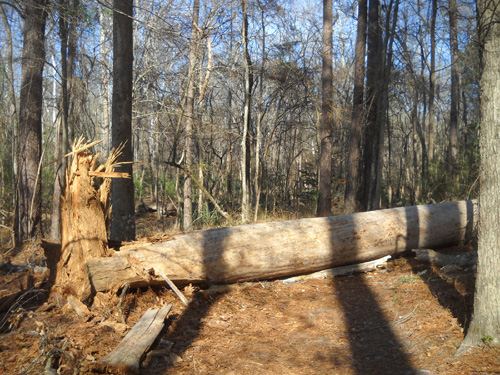
That one is almost three feet in diameter.
One of the trees smashed a long bog bridge and the race course was
re-routed along the side:
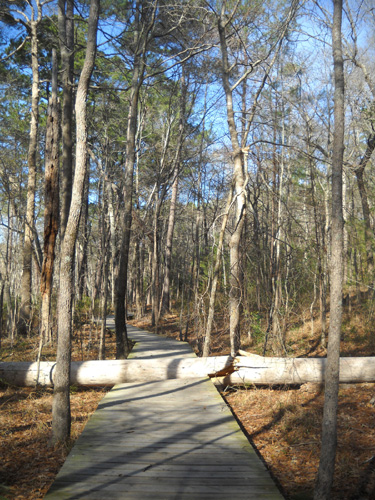
Prairie Branch Trail next to the east side of the lake was a real mess after the storm hit
last Tuesday morning. I spent several hours on Tuesday and Wednesday removing limbs and branches
from that 1½-mile loop, most of which is on
the race course.
My motive wasn't
totally altruistic; I've been going out on that trail daily for
walks because it is the most scenic one in the park and the closest to
our campsite.
I joked with Jim that we should get a free night of camping for all
the work I did removing debris from that trail! Picking up limbs and
branches on trails was part of our camp hosting job at Brazos Bend SP
last year. Free camping was our reward.
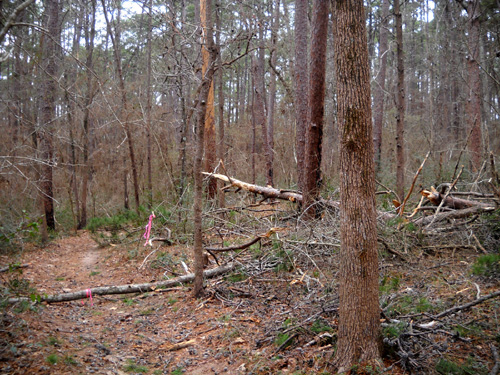
Smaller trees down on the Chinquapin Trail across
the lake
Wednesday afternoon I saw that someone had marked the race course
with ribbons. I was familiar with the courses and realized
that some of the markers were placed incorrectly on the inner Prairie
Branch Loop. I didn't move them, but told Jim so he could let RD Joe Prusaitis
or Henry Hobbs (the guy in charge of course marking) know.
The ribbons were placed correctly by race day.
THURSDAY, FEB. 3
All the other signs and arrows were in place by Thursday, when Cody
and I hiked about nine miles around the lake. I rode my bike another 1½
hours after that, covering another part of the race course.
By that afternoon Joe and his crew had all the aid stations and race
HQ (Dogwood aid station) in place:
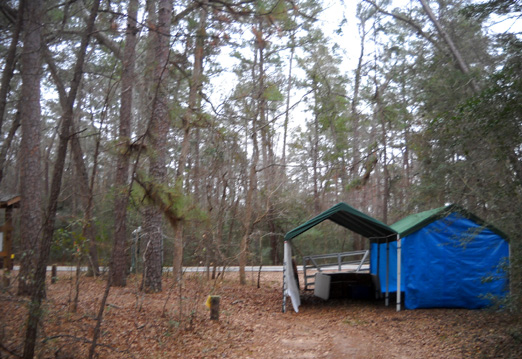
Park Road Aid station
I was on my bike that day when I "ran
into" three very fast runners, one of them Karl Meltzer, on the
Chinquapin Trail. Cool! I didn't recognize the other two guys. This race
attracted some well-known elite runners. I'll talk more about them in a
bit.
The Rocky loops have
many turns but, as usual, they were marked so well that even incoherent
100-mile runners should not have gotten lost during the race.
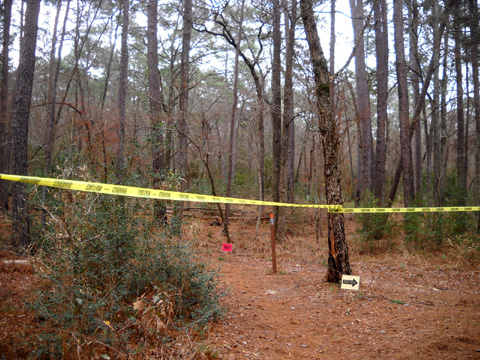
Yellow tape and red signs
indicate "don't go
there."
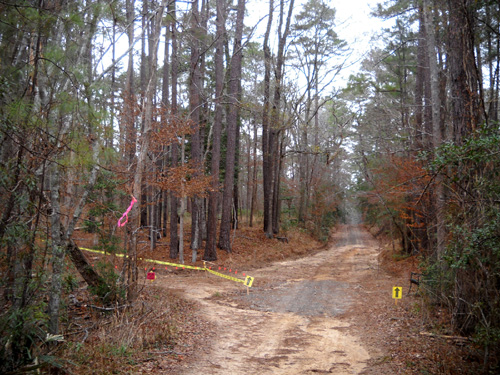
Amy's Crossing (intersection of
Chinquapin and CCC trails on south side of park)
Volunteers
were also putting the finishing touches on a new bridge on the
Chinquapin Trail near Amy's Crossing:
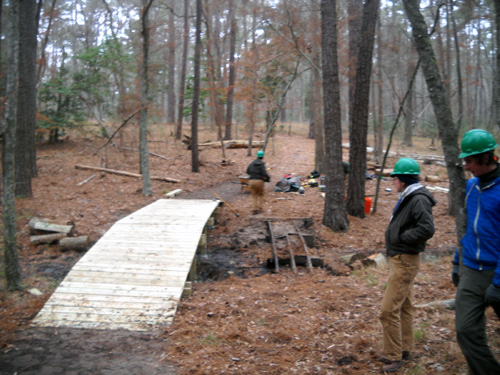
They were just cleaning up and I got to "initiate" the bridge.
Runners got to use it during the race.
FRIDAY, FEB. 4
We woke Friday morning to find about half an inch of sleet and snow
on the ground. That was much better than the predicted 3-4" of white
stuff. The temperature hovered around 20°F.
We were happy to stay inside our cozy camper all morning.
After lunch we walked around the Prairie Branch loop and had to
avoid most of the bog boards, which were so icy they were downright dangerous. We
could barely walk on them without slipping, sliding, and/or falling
down. Even Cody had trouble getting traction:
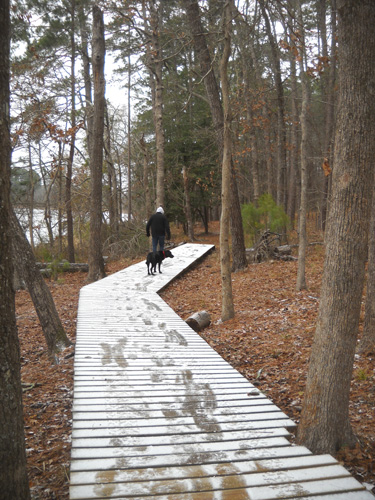
The slanted ends were especially dangerous:
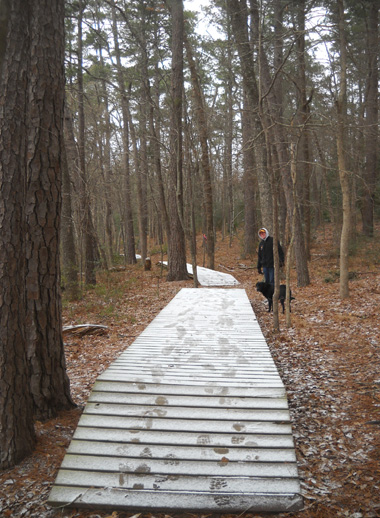
Oh, my. We wondered how the runners could possibly run across
them in the morning . . . Jim and Cody even walked around that
one.
The course was re-routed around the long bridge the tree smooshed:
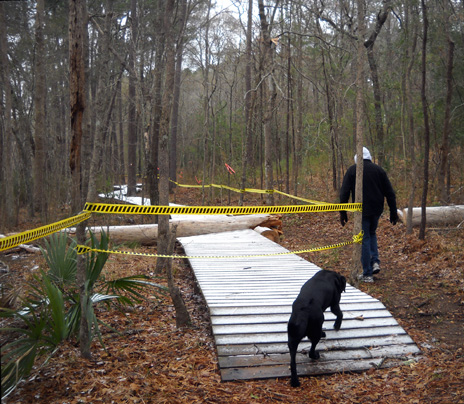
Good thing. If anyone had hurdled that tree in the morning they'd slide
a good ways on the other side.
The other large tree farther up Prairie Branch had been cut by Friday so
runners didn't have to detour around it:
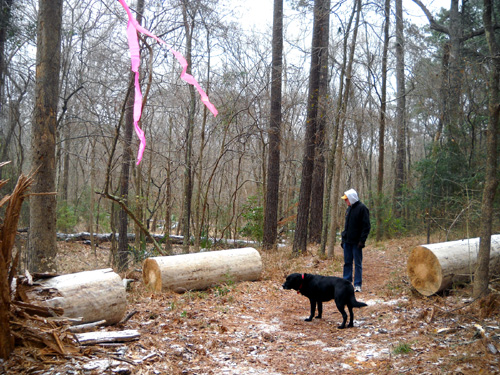
Jim and Cody give perspective to how large that sucker was.
Sure glad I wasn't out on the trail when that thing came down. I usually
avoid trails in pine forests on really windy days. Even a falling limb
can kill you.
TOUGH CONDITIONS FOR RUNNERS, TOO
Temperatures at Huntsville State Park ranged from the teens at night to the upper 20s F.
during the day from Wednesday to Friday. That's about 25°F.
below normal, not what most runners expected when they signed up for
this race.
Fortunately, we dodged the predicted 3-4" of sleet and/or snow
overnight Thursday/Friday at the park and got just a light dusting. Even though the sun
came out on Friday afternoon it was still below freezing when runners
showed up in town to pick up their race packets and attend the pre-race
dinner. It got even
colder that night, down to 19°F.
In addition to the challenges race management faced with the frigid
weather at Huntsville as they marked the course
and set up headquarters and the aid stations, runners from around the world
found themselves with challenges just getting here.
Airports all around the country and even in Houston were affected by
the massive storm system that lasted several days before the race. Some
people couldn't fly in or out.
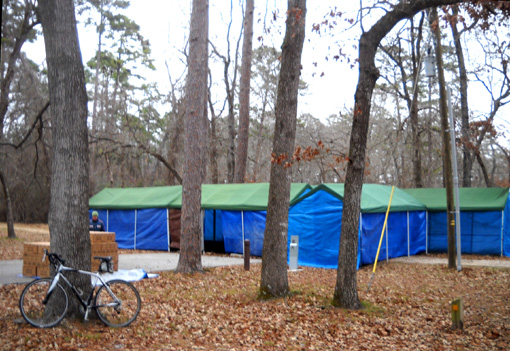
Race headquarters AKA Dogwood
Aid Station (start/finish/turnaround point)
on Thursday
What was so ironic to Jim and me was that we were in the park . . .
but unable to run.
And there were quite a few runners willing and able to run . . . but unable to get here for the race!
Not only were airports snarled across the country, even the roads in
much of Texas were icy and nearly impassable on Thursday and Friday. We
read tweets and ultra list posts by runners who had difficulty driving
I-45
between Dallas and Huntsville -- and other roads leading to the
race.
According to RD Joe Prusaitis' post-race
report, only 512 of the 700 race
registrants made it to the starting line. It's common for ultras to have
up to a 10% DNS (did not start) rate, but not this high.
Fortunately, some of the runners were able to keep or change their flights
and get here on time. Tammy Massey comes to mind. She initially posted
to the ultra list that she wouldn't be able to get out of Baltimore but she did. Other friends like Julie and Val Aistars from Chicago,
Paul Grimm from Colorado,
and Kathy Lang/Jim Ballard from Oregon had to miss the race because of
the weather.
For the hundreds of runners who did make it to the race
start . . . I'll describe later in this entry the challenging course conditions
they faced early yesterday morning.
WHY IS ROCKY SO POPULAR?
This is the 19th year for the
Rocky Raccoon 100-miler. The 50-miler
was added more recently.
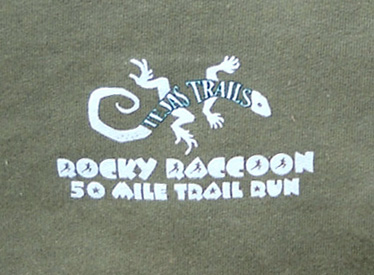
Race logo on Jim's sweatshirt
Both races have become very popular for a number of reasons:.
- The event is well-organized and has a good reputation. Joe & Co.
know how to put on a good race. Tejas Trails has an entire series of
trail races from 5K to 100 miles in length.
- It's in an appealing location in the dead of winter, usually
warmer than most other places in the U.S.
- There are no qualifying standards to get in.
- The entry fee is moderate.
- Up to 700 runners can enter (i.e., no lottery or quick close-out).
- The scenic, multi-loop course is not too hilly and not too flat.
- The footing is mostly good, making it a relatively "fast" course.
- There is historically a pretty high finish rate.
- It is so well marked that runners don't tend to get lost.
- Chip-timing = accurate splits. (Real-time internet splits didn't
work very well, though.)
- The aid stations are well-spaced, well-stocked, and manned by
competent volunteers, many of whom are either ultra runners themselves
and/or have worked this race many times.
- It's an excellent race for first-timers at either distance.
- The 100-mile race has a 30-hour limit and allows slower runners to
start an hour early so they don't miss the awards breakfast (they
still must finish within 30 hours to buckle, however).
- Fifty-milers have a generous 29 hours to finish, allowing walkers
and slow runners
to participate.
In this day and age with some of the popular 100-mile races closing out in a matter
of minutes or having lotteries with tough odds for entry, Rocky is a
great opportunity for runners of every caliber to experience a well-run
(pun intended) race.
COME ONE, COME ALL
One of the problems with the growth spurt in ultrarunning the last few years
-- primarily
due to publicity by/about Dean Karnazes and from Christopher McDougal's
book Born to Run -- is the difficulty for a bunch
of elite runners to
enter some of the most popular races where they can compete against each
other.
Some would say they deliberately avoid competing against each
other so they can win more races, but recent blog entries by some of the
sport's top runners indicate they want to compete against each
other. They know that competition makes them run harder and smarter.
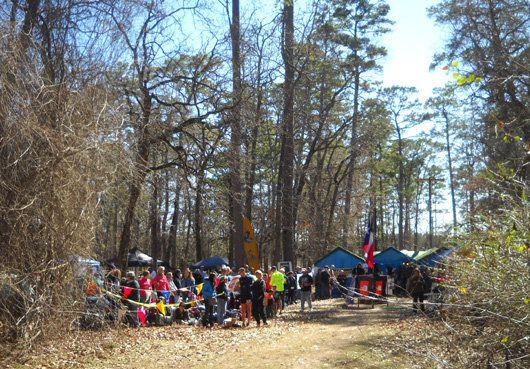
Approach to the Dogwood AS during the race;
this was the turnaround point after each loop.
So it was exciting to read on the internet ultra list that Rocky
Raccoon might be the first time some of these guys would test
themselves against each other this year.
It's early in the season,
however, and most of them have more prestigious and/or international
races later in the year in which they hope to peak, but Rocky allowed
them an opportunity to decide quite close to the race date whether or
not to enter.
It's not like Western States where they have to get their dibs in many months in
advance and hope to make the lottery, or Hardrock where speed isn't as
important as having finished at least five times previously and securing
a guaranteed entry.
Nope, with Rocky they could decide within a few days of the race whether
they wanted to compete. It's great that there are opportunities like
this -- for slugs as well as gazelles. All any potential participant had
to do was watch the entry list and make their decision before the races reached their
max.
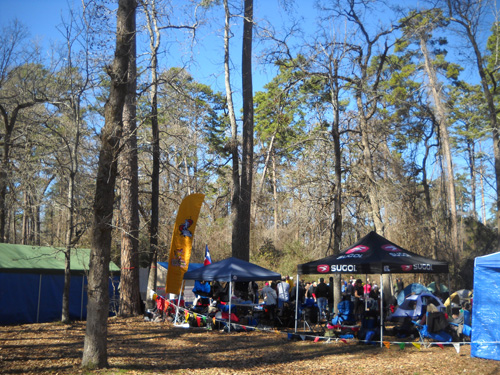
Crews await their runners at
Dogwood.
As word spread among the
fast guys, more signed up.
This year anticipation ran high on the internet in the last couple of weeks
before the race when folks saw new names appear on the entry list --
Karl Meltzer, Scott Jurek, Anton Krupika, Hal Koerner, Zach
Gingerich, Mike Wolfe, and some fast guys Jim and I weren't familiar
with like Ian Sharman, Michael Arnstein, and Bill Fanselow.
I kept hoping Geoff Roes would enter, too, but never saw his name.
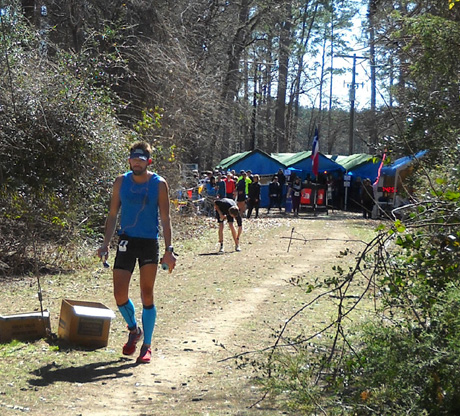
Hal Koerner walks out of the
Dogwood aid
station at 60 miles to begin his fourth 20-mile loop.
Internet chatter revolved around whether one of these guys would be
able to break Eric Clifton's course record of 13:16:02 set fifteen years
ago.
Maybe with good weather, but in the abnormally frigid weather we had
leading up to race day??
The cold start on Saturday morning may have actually been A Good
Thing
for most of these guys who have been training all winter in worse
conditions than this! What they were less acclimated to was the sunny
60-degree F. temperature on Saturday afternoon. But that didn't prevent
the record from being shattered.
Oops. I'm getting ahead of myself . . .
RACE DAY ACTION
Although Jim did pick up his race packet and timing chip on Friday,
he wisely chose to not start the 50-miler on Saturday morning. He needs
to let his knee heal.
We deliberately slept late, missing both the 100-mile start at 6AM and the 50-mile
start at 7AM. It would have been harder for him to see our friends start
those races and not be among them. It also removed any temptation to
change his mind and run.
He turned in his timing chip after lunch.
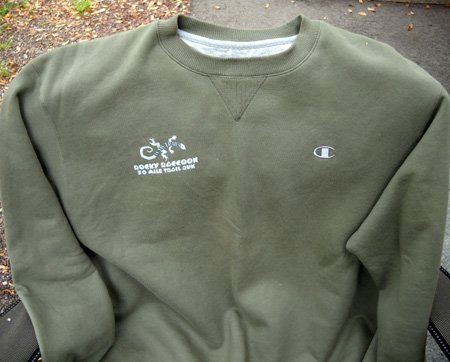
Handsome race sweatshirt in Jim's
entry bag
As predicted, temperatures were in the high teens F. That meant the bog
boards were still frozen. I'm not sure how many runners were aware of
that before they literally hit the first ones.
When we got up we checked the race website to see if there were any
updates. Those were delayed significantly, but we found lots of tweets
from spectators and runners (!) who indicated that the frozen bog boards
were indeed causing problems for runners the first few hours until the
sun warmed them up enough to melt the ice.
Reportedly a couple of runners were injured from falls off the
bridges and had to withdraw from the race. There are bog bridges all
around the lake. Along the Prairie Branch Trail it appeared later that
runners simply ran off to the side of all the bridges there but they
couldn't do that through a couple swampy areas on the Chinquapin Trail.
Even that didn't slow the front runners down by much.
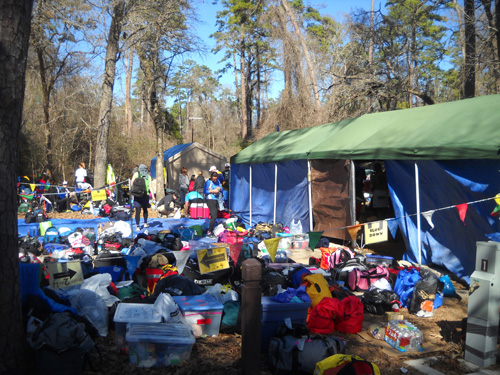
Drop bag area at Dogwood (start/finish/turnaround)
The afternoon eventually warmed up to about 60°F. It was beautiful
with the sun shining, probably too warm for some of the runners from
northern states but welcomed by most of the volunteers and spectators.
Jim and I watched the delayed splits and read real-time tweets on the computer in the morning.
We also went into town to do laundry and run some errands. We didn't go up to the
start/finish area until after lunch to see friends come and go from the
aid station at the end/beginning of their loops.
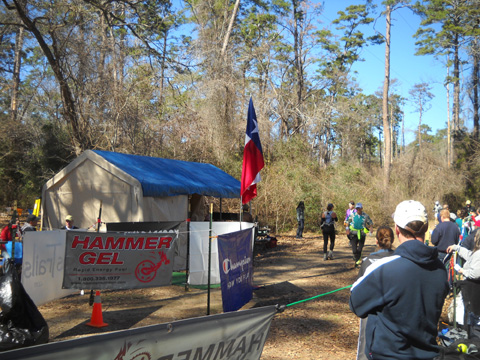
Above and below: our vantage point at Dogwood
Aid Station
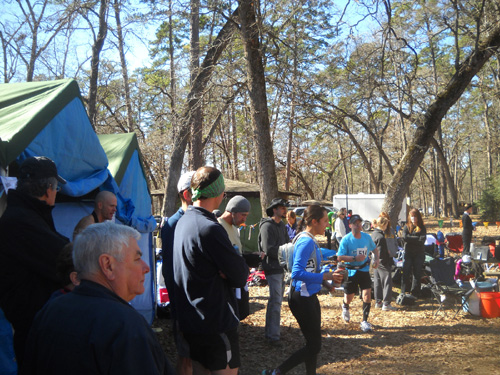
It was fun to watch several runners we know come in. We saw some of
the front-runners (Scott, Anton, Karl, and Hal) coming in at 60 miles,
as well as friends like Anne and Matt Watts:
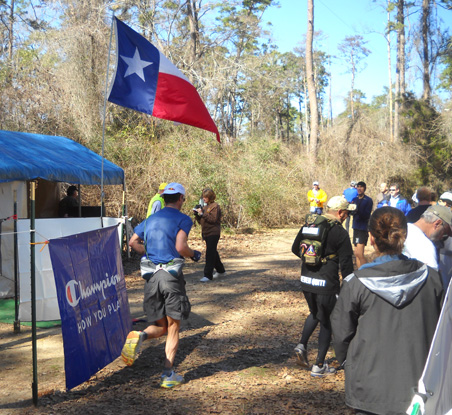
I missed Karl Meltzer when he
came in but got him going out of the aid station (blue shirt).
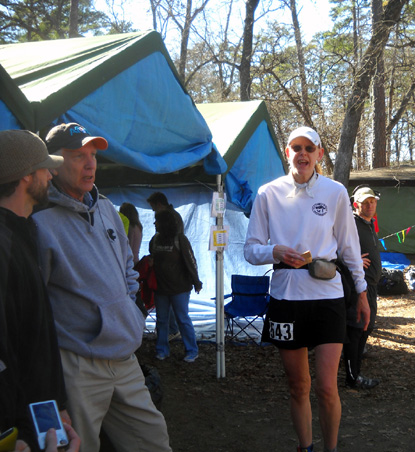
Anne looks great after running two of her three 16+
mile loops.
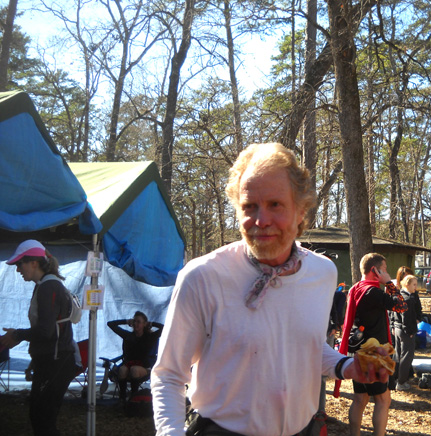
So does Matt after 40 miles!
We were surprised to see Scott Jurek spending so much time talking
with friends and RD Joe Prusaitis:
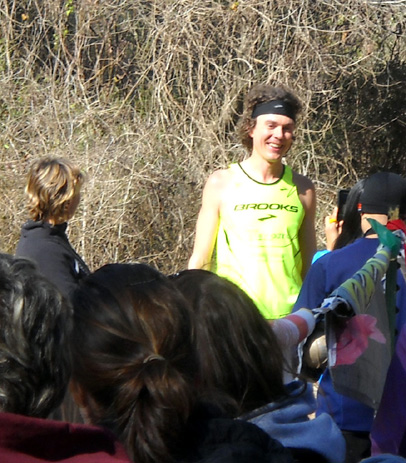
Scott Jurek talks with friends,
above, and RD Joe Prusaitis, below.
Have you ever looked that good after
running fast for 60 miles???
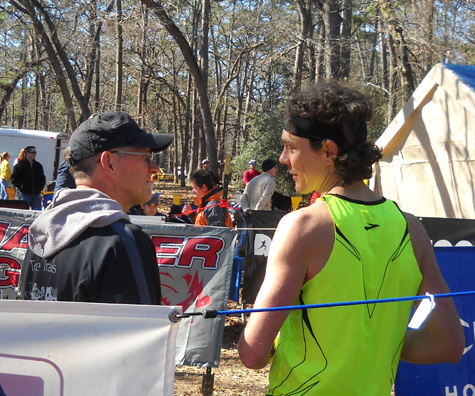
I understood when I heard Scott tell Joe that he intended to run only 60 miles, as it's too early
in his training season to do a good 100-mile race. That was some
training run! Most of the other fast guys kept
on going.
THE VIEW FROM PRAIRIE BRANCH
Later in the afternoon I walked along the lake on Prairie
Branch Trail to watch runners come and go for a couple of hours.
Traffic is two-way in this section about two miles from the
start/finish area. It's a nice, quiet spot to view the action away from
crowded aid stations.
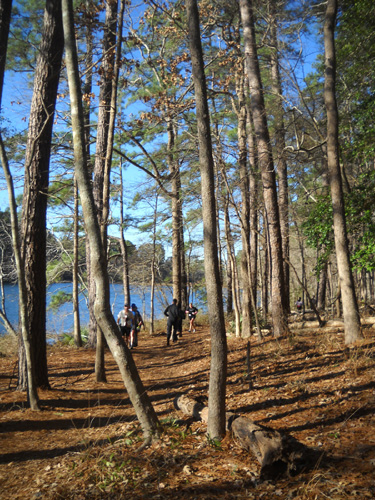
My view to the north
By now the fastest 100-milers were 78 to 82 miles into their races, the
mid-packers 58 to 62 miles in, and the back-of-the-pack at 38 to 42 miles.
Some of the slower runners didn't finish as the temperatures plummeted again during
the night.
There were also inbound 50-milers who were near the finish of their races and
others who had to go out on another 16+-mile loop. The first 50-milers
were already done an hour or two earlier.
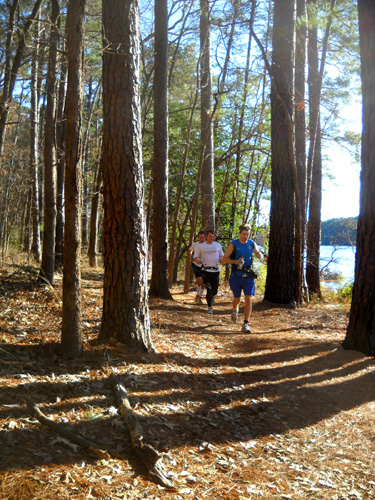
My view to the south
I stayed out on the trail for a couple of hours before the sun set. I
sat on a bench overlooking the lake and was able to take photos and
offer encouragement to all the passing runners. I tried not to surprise anyone. Unless they were totally focused on
their music or inner voices, they could see me from either direction
before reaching the bench. I was several feet off the trail but visible.
Some of the runners stopped to talk to me, grateful for
an excuse to stop for a little while. One woman stayed a couple of minutes
in both
directions. I had to encourage her to get moving again! A couple runners recognized me from this website, which is
one of the reasons I maintain it. It's great to meet people because of
these journals.
WHERE ARE THOSE FAST DUDES?
I was looking not only for friends but also for #6, Ian Sharman. I
hadn't heard of him before this race but knew from the tweets and web
splits that he
was in the lead most of the race.
Ian came by so fast at 78
miles that I missed getting his picture. I was determined to "catch"
him when he came back four miles later. I saw him coming -- with a female pacer,
to my delight
-- and got a good
picture. I sent it to Ultrarunning magazine and hope it
is good enough to be used in their article about the race in the
March or April
issue.
This is a cropped version so you can see it better on the
computer:
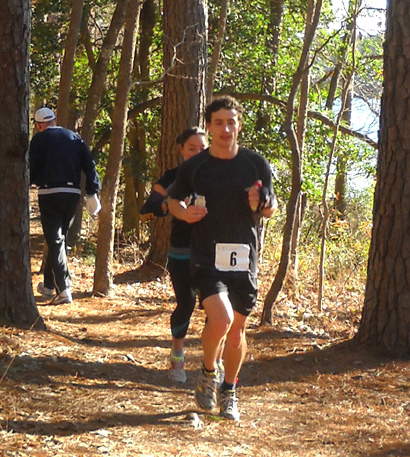
Ian Sharman with pacer at 82 miles
We don't get the magazine any more so if anyone sees a picture of Ian
that is credited to me, please let me know. I was very impressed with
how seemingly effortlessly he floated by after running for 82 miles.
It was fun to see Anton and Hal come by a few minutes later. I missed
them inbound, too, but got their photos outbound at 82 miles:
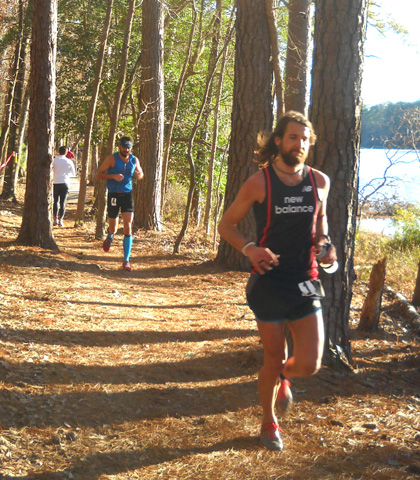
Anton leads Hal (in blue shirt
and compression socks)
by only a few strides at 82 miles.
Both runners were focused and also looked to be in excellent shape despite
the miles they'd already covered.
Later I spotted Davy Crockett inbound. He appeared to be running the same pace as Karl
Meltzer, who was right behind him, but the Speedgoat was actually 20
miles ahead of Davy at that point. Karl is mostly hidden behind a tree
in the first photo:
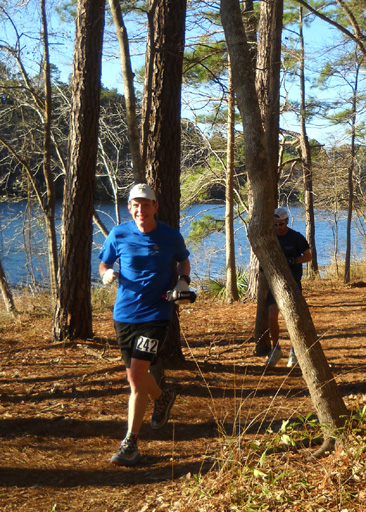
Above and below: Davy Crockett "paces" Karl Meltzer for a few
miles.
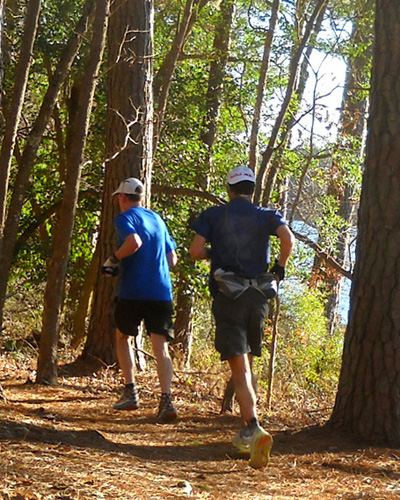
I got a better shot of Karl as I was walking back to our camper and
he was coming down the Prairie Branch Trail toward the lake. He was
outbound on his last loop, about 81½ miles
into the race. That picture is the next one below.
EXCITING 100-MILE FINISH
We considered going to the finish area after eating supper but again,
we just weren't motivated. It was fun to watch the (delayed) results
during the day and wonder if Ian could keep his lead and/or break the
old record of 13:16. If he had a good 5th loop, he might break 13 hours!
Even that possibility wasn't enough to nudge us out the door, however.
By all accounts the finish line was packed after 6PM as 11-hour
50-milers were finishing and anticipation grew about whether Ian
Sharman, Anton Krupika, or Hal Koerner would break 13 hours (7PM) in the 100-mile race. Karl Meltzer had slowed down and was
running in fourth place, not likely to break 13 but not a shabby pace,
either..
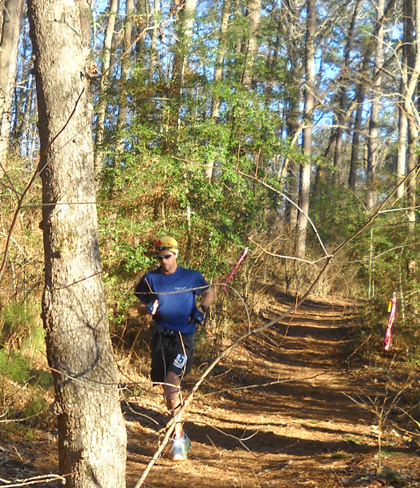
Karl at about 81½
miles, heading down toward the lake on Prairie Br. Trail
To the delight of the crowd, Ian blew away the old course record by
over 31 minutes, finishing in an astounding 12:44:33 at 6:44PM. That may
be the fastest 100-mile trail time in history.
Imagine running a 7:39 pace on dirt trails for 100 miles.
That
includes time to drink, eat, pee, take clothes on and off as the
temperature ranged between 19-60°F., and do whatever else needed doing
during the day
-- which means he was actually running even faster than
that!
Incredible. Simply incredible.
Anton and Hal battled for second place
for most of the race. Afterwards they both said the competition brought
out the best they could do that day. Anton finished second in 3:18,
faster than when he won the race in 2007 (13:32) but not fast enough to
break Eric Clifton's old record. Hal came in third in 13:26. Karl was
fourth an hour later in 14:27.
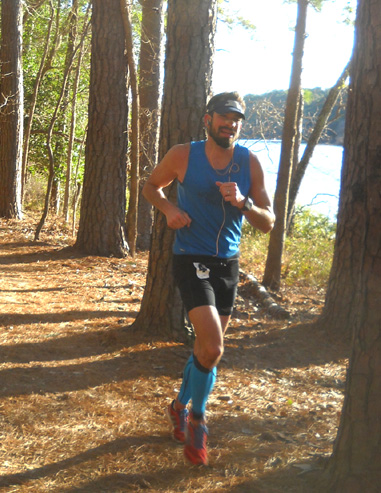
Hal Koerner at 82 miles
The women's race was less exciting only
because Liza Howard had no female competition. She finished in fifth
place overall in 15:33 to place first female for the second year in a
row. It was a course PR for her by about 12 minutes.
Early in the race
she was up there with the men, then realized she was going too fast. Her
blog
entry about the race is interesting and amusing. Liza's nearest
competition, Brenda Carawan, was seven hours behind her.
RACE RESULTS
Click
here for 2011 results in both races.
Click
here for prior year race results and
some good photos of this year's top runners. #1 is Anton Krupika, #4 is
Hal Koerner, #5 is Karl Meltzer, and #6 is Ian Sharman. Note the frost
on Anton's beard in one of the photos.
Liza Howard is probably #8 in the pink shirt. I can't find a list of
the runners' numbers now and I don't know what she looks like.
Here's a list of some of the top runners' race reports on their websites
or blogs:
Ian Sharman: http://sharmanian.blogspot.com/
Anton Krupika:
http://antonkrupicka.blogspot.com/
Karl Meltzer:
http://karlmeltzer.com/
Scott Jurek:
http://www.scottjurek.com/blog/
Liza Howard:
http://lizahoward.wordpress.com/
I can't find a blog or website for Hal Koerner.
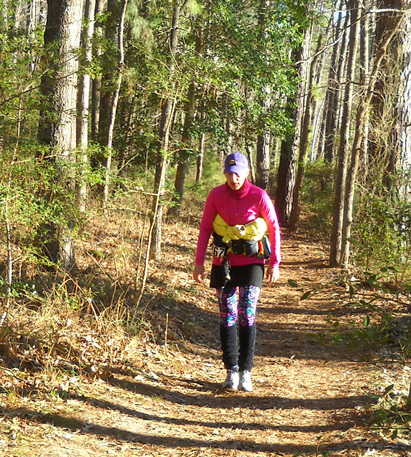
Kim Sergeant is bundled up for her fourth
loop in the 100-mile race.
It will soon be dark, and the temperature
was quite cold again Sat. night.
Davy Crockett's race reports are always interesting, too. In his
Rocky
report he talks about how much
fun it was to speed up mid-race to run with Karl for several
miles. Davy ran a fine 21:22 to finish in 34th place overall.
The winner of the 50-mile race also set a new course record.
Todd Braje ran a quick 5:43 to beat his nearest competitor by
33+ minutes and smash the previous record of 6:01. Maria Clemente, first female and 11th overall in
that race, finished in 7:34.
Per RD Joe Prusaitis' race
report, the 100-mile finish
rate was the lowest in the 19-year history of the race:
190 out of 316 who started the race = 60%. Fifty-milers fared
better, with a finish rate of 85% (166 of 196 who began the
race).
Most of our friends did well in their respective races.
For example, in the 50-miler Anne Watts came close to her goal of 12 hours, finishing in 12:05. Larry Hall finished in 7:52 to
place 13th overall. Tammy Massie ran to a 9:30 finish, a great
start to her training for the Grand Slam this summer. Grant Holdaway
(Wendy's dad), still going strong at age 79, finished in 14:55.
Deborah Sexton was a few seconds behind him in 14:56.
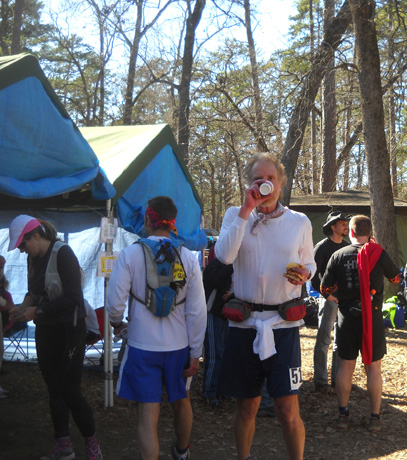
Matt wisely takes a little time to eat and
drink at 40 miles.
In the 100-mile race
Matt Watts (above) ran a strong, steady 23:54 to break 24 hours. Larissa Dannis, friend of a friend who was running her first 100-miler,
finished well in 25:10. Some other friends who finished the
100-miler were Beth Simpson-Hall (26:37), Dennis Drey (27:53),
Allan Holtz (28:59), and Jean-Jacques d'Aquin (29:01 at age 71),
THE AFTERMATH
We woke to sunshine and a temperature of 38°F.
on Sunday morning. It rose to 56°F. by the time we left the park
at 11AM to head farther south to Brazos Bend State Park. We did
not go to the race finish to see the last runners come in, nor
did we stay in Huntsville long enough to attend the awards
breakfast.
When we left the park most of the finish line tents and canopies were down,
as were the two aid stations we passed on the park road on our
way out to I-45. Race staff and/or volunteers do a good job of
clean-up after this race, although in previous years when we've
stayed longer I've seen trash (mostly toilet paper) out on the
trails the next day.
I'll pick up litter, but not used t.p.!
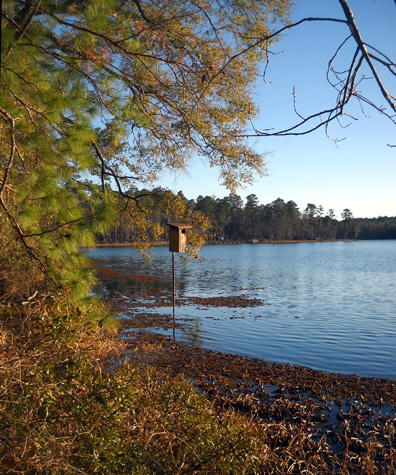
Birdhouse on a post in Lake Raven along the
Prairie Branch Trail
Since we weren't involved as volunteers for the race this year
we don't know if anything major went wrong besides the cold
weather, difficulties of both volunteers and runners getting to
the race site, injuries from icy bog boards, and hiccups
with the "live" internet race results. Race staff is
responsible for only the results. The runners' internet race reports
I've read had no complaints. Neither did the thank-you's posted
on the race website.
The 500+ runners who made it to the race appear to be
satisfied once again, attesting to the skills and hard work of
Joe Prusaitis, the other Tejas Trails staff members, and
numerous dedicated volunteers who make this race "run" so well.
We recommend this race if you haven't run it before.
As long as Jim continues to run ultras, we'll probably be back.
If all 700 runners ever show up, the race starts will be very
crowded but the runners spread out fairly quickly. That --
and parking, if you aren't officially camping in the park the
night before the race -- are the main downsides of this
event.
If you check out the weather history on the race website you'll
see that this year's weather was an anomaly. Don't let that
scare you off.
Next entry: an extended stay at one of our other
winter Texas "homes," Brazos Bend State Park
Happy trails,
Sue
"Runtrails & Company" - Sue Norwood, Jim O'Neil,
and Cody the Ultra Lab
Previous
Next
© 2011 Sue Norwood and Jim O'Neil





































